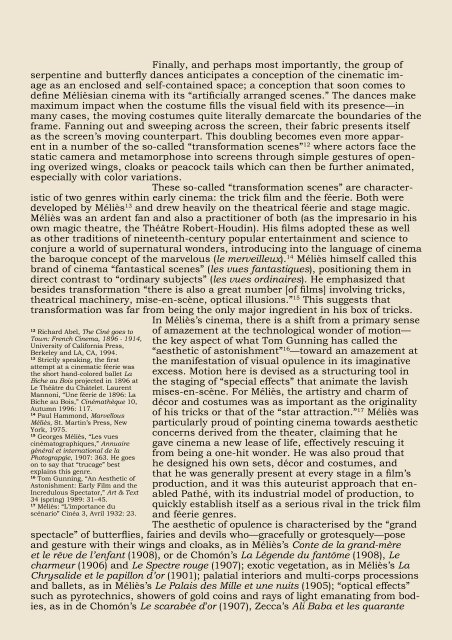Download the full program as PDF - Fashion Film Festival
Download the full program as PDF - Fashion Film Festival
Download the full program as PDF - Fashion Film Festival
Create successful ePaper yourself
Turn your PDF publications into a flip-book with our unique Google optimized e-Paper software.
Finally, and perhaps most importantly, <strong>the</strong> group of<br />
serpentine and butterfly dances anticipates a conception of <strong>the</strong> cinematic image<br />
<strong>as</strong> an enclosed and self-contained space; a conception that soon comes to<br />
define Mélièsian cinema with its “artificially arranged scenes.” The dances make<br />
maximum impact when <strong>the</strong> costume fills <strong>the</strong> visual field with its presence—in<br />
many c<strong>as</strong>es, <strong>the</strong> moving costumes quite literally demarcate <strong>the</strong> boundaries of <strong>the</strong><br />
frame. Fanning out and sweeping across <strong>the</strong> screen, <strong>the</strong>ir fabric presents itself<br />
<strong>as</strong> <strong>the</strong> screen’s moving counterpart. This doubling becomes even more apparent<br />
in a number of <strong>the</strong> so-called “transformation scenes” 12 where actors face <strong>the</strong><br />
static camera and metamorphose into screens through simple gestures of opening<br />
overized wings, cloaks or peacock tails which can <strong>the</strong>n be fur<strong>the</strong>r animated,<br />
especially with color variations.<br />
These so-called “transformation scenes” are characteristic<br />
of two genres within early cinema: <strong>the</strong> trick film and <strong>the</strong> féerie. Both were<br />
developed by Méliès 13 and drew heavily on <strong>the</strong> <strong>the</strong>atrical féerie and stage magic.<br />
Méliès w<strong>as</strong> an ardent fan and also a practitioner of both (<strong>as</strong> <strong>the</strong> impresario in his<br />
own magic <strong>the</strong>atre, <strong>the</strong> Théâtre Robert-Houdin). His films adopted <strong>the</strong>se <strong>as</strong> well<br />
<strong>as</strong> o<strong>the</strong>r traditions of nineteenth-century popular entertainment and science to<br />
conjure a world of supernatural wonders, introducing into <strong>the</strong> language of cinema<br />
<strong>the</strong> baroque concept of <strong>the</strong> marvelous (le merveilleux). 14 Méliès himself called this<br />
brand of cinema “fant<strong>as</strong>tical scenes” (les vues fant<strong>as</strong>tiques), positioning <strong>the</strong>m in<br />
direct contr<strong>as</strong>t to “ordinary subjects” (les vues ordinaires). He emph<strong>as</strong>ized that<br />
besides transformation “<strong>the</strong>re is also a great number [of films] involving tricks,<br />
<strong>the</strong>atrical machinery, mise-en-scène, optical illusions.” 15 This suggests that<br />
transformation w<strong>as</strong> far from being <strong>the</strong> only major ingredient in his box of tricks.<br />
In Méliès’s cinema, <strong>the</strong>re is a shift from a primary sense<br />
of amazement at <strong>the</strong> technological wonder of motion—<br />
<strong>the</strong> key <strong>as</strong>pect of what Tom Gunning h<strong>as</strong> called <strong>the</strong><br />
“aes<strong>the</strong>tic of <strong>as</strong>tonishment” 16 —toward an amazement at<br />
<strong>the</strong> manifestation of visual opulence in its imaginative<br />
excess. Motion here is devised <strong>as</strong> a structuring tool in<br />
<strong>the</strong> staging of “special effects” that animate <strong>the</strong> lavish<br />
mises-en-scène. For Méliès, <strong>the</strong> artistry and charm of<br />
décor and costumes w<strong>as</strong> <strong>as</strong> important <strong>as</strong> <strong>the</strong> originality<br />
of his tricks or that of <strong>the</strong> “star attraction.” 17 Méliès w<strong>as</strong><br />
particularly proud of pointing cinema towards aes<strong>the</strong>tic<br />
concerns derived from <strong>the</strong> <strong>the</strong>ater, claiming that he<br />
gave cinema a new le<strong>as</strong>e of life, effectively rescuing it<br />
from being a one-hit wonder. He w<strong>as</strong> also proud that<br />
he designed his own sets, décor and costumes, and<br />
that he w<strong>as</strong> generally present at every stage in a film’s<br />
production, and it w<strong>as</strong> this auteurist approach that enabled<br />
Pathé, with its industrial model of production, to<br />
quickly establish itself <strong>as</strong> a serious rival in <strong>the</strong> trick film<br />
and féerie genres.<br />
The aes<strong>the</strong>tic of opulence is characterised by <strong>the</strong> “grand<br />
spectacle” of butterflies, fairies and devils who—grace<strong>full</strong>y or grotesquely—pose<br />
and gesture with <strong>the</strong>ir wings and cloaks, <strong>as</strong> in Méliès’s Conte de la grand-mère<br />
et le rêve de l’enfant (1908), or de Chomón’s La Légende du fantôme (1908), Le<br />
charmeur (1906) and Le Spectre rouge (1907); exotic vegetation, <strong>as</strong> in Méliès’s La<br />
Chrysalide et le papillon d’or (1901); palatial interiors and multi-corps processions<br />
and ballets, <strong>as</strong> in Méliès’s Le Palais des Mille et une nuits (1905); “optical effects”<br />
such <strong>as</strong> pyrotechnics, showers of gold coins and rays of light emanating from bodies,<br />
<strong>as</strong> in de Chomón’s Le scarabée d’or (1907), Zecca’s Ali Baba et les quarante<br />
Frame enlargement from Métempsycose, dir Segundo de Chomón, 1907. Courtesy of AFF/CNC, France.<br />
voleurs (1902) or Velle’s La poule aux oeufs d’or (1905); or dazzling underwater<br />
kingdoms, <strong>as</strong> in Ferdinand Zecca’s Pêcheur de perles (1907). Many of <strong>the</strong>se <strong>the</strong>mes<br />
appear at <strong>the</strong>ir best in <strong>the</strong> so-called apo<strong>the</strong>oses, <strong>the</strong> triumphal scenes and <strong>the</strong> ultimate<br />
glorifications of opulence which typically involve <strong>the</strong> whole troupe in ballets<br />
or o<strong>the</strong>r, more ambitious formations. This is where cinema used and reinvented<br />
some of <strong>the</strong> <strong>the</strong>atrical machinery that defined <strong>the</strong> nineteenth-century féerique.<br />
Among all <strong>the</strong> motifs that showc<strong>as</strong>e costume <strong>as</strong> a living<br />
screen, those of women-butterflies (femme-papillon),<br />
women-insects and winged fairies are <strong>the</strong> most persistent<br />
and also <strong>the</strong> most emblematic. These fin-de-siècle<br />
phenomena were already familiar tropes from stage<br />
magic and féerie; one of Méliès’s first cinematic butterfly-women,<br />
in La Chrysalide et le papillon d’or, w<strong>as</strong> in<br />
fact b<strong>as</strong>ed on a famous stage illusion called The Cocoon<br />
(Le Cocon) by French magician Buatier de Kolta 18 shown<br />
in <strong>the</strong> Egyptian Hall in London in 1887, shortly after<br />
Méliès’s own brief stint <strong>the</strong>re. 19 De Kolta’s trick w<strong>as</strong> <strong>the</strong>n recreated again in G<strong>as</strong>ton<br />
Velle’s Métamorpsoses du papillon (1904) and de Chomón’s Maripos<strong>as</strong> japones<strong>as</strong>/Papillons<br />
japonais (1908), both of which are colored. Ano<strong>the</strong>r remarkable film<br />
by de Chomón, Métempsycose (1907), w<strong>as</strong> also b<strong>as</strong>ed on an eponymous popular<br />
magic illusion which w<strong>as</strong> essentially a variation on <strong>the</strong> Pepper’s Ghost. The film’s<br />
main attraction is a female figure who repeatedly opens and closes arms, each<br />
time unveiling a new pair of wings that turn into a cape decorated with motifs<br />
that, once again, evoke Fuller’s early painted costumes.


